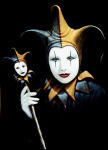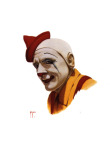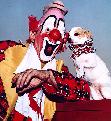Whiteface Clowns
There are three types of Whiteface Clowns: Straight Whiteface, (classic) European
Whiteface, and (comedy) grotesque Whiteface |
|
 |
(Classic)
European Whiteface |
 |
|
 |
Character: Also commonly
called the Pierott clown. An elegant clown, artistic, colorful, bright and cheery. Its
performance is highly artistic and skillful, but done with a comedic or dramatic flair. |
|
 |
Makeup: All exposed flesh
will be covered with white makeup. Minimal lining color(s) and/or glitter will be used to
express the features of the eyes, nose, and mouth. A white skull cap could be worn in lieu
of a colored wig. The European Whiteface generally does not wear a comedy nose, false
eyelashes, or large ears. |
|
 |
Costume: Considered the
"most beautiful" of all clowns, it would be outfitted with the traditional one
or two-piece jump suits of white or colored material to fit the character of the Classic
Pierott. The styles may vary but are generally roomy and well-fitted and may have a
detachable collar. The tunic or blouse can be straight, flared, short, medium or long with
the long sleeves. Buttons, pompons, piping and ruffles should be of a contrasting color.
The pants can be straight, flared, ruffled, or pantalooned. A clown hat should fit the
clown's character/personality (short or tall cone hat, short cup or flat hats, or the
typical "Pagliacci" hat). Gloves should cover the hands and wrists and should be
white or colored to fit the wardrobe. Ballet or dancing slippers would be worn in lieu of
large comedy shoes. |
|
|
|
|
|
 |
Straight
Whiteface |
 |
|
 |
Character: The aristocrat
of all clowns. An elegant clown, artistic, colorful, bright and cheery. In a setting with
other clowns, the straight Whiteface would be in charge. Its performance is highly
artistic and skillful, but done with a comedic or dramatic flair. When performing with the
Auguste and/or Tramp, this clown will remain in charge, setting up the routine, throwing
rather than taking the pie, slap or kick. Although more comical than the European
Whiteface, this clown is a bit more reserved than the impish and gregarious Auguste. |
|
 |
Makeup: All exposed flesh
will be covered with white makeup. Minimal lining color(s) and/or glitter will be used to
express the features of the eyes, nose, and mouth. Varying styles and colors of clown wigs
are used |
|
 |
Costume: The costume will
fit well. Satins, sequins, rhinestones and theatrical fabrics (shiny, flashy, beaded,
etc.) can be used. A one or two piece jumper worn with a ruff is the most common Whiteface
costume. However, a two piece suit or tuxedo style is also acceptable. The costume
including the accessories should be color coordinated. Shoes can be large or small but
should be simple. Gloves should always be worn. in lieu of only the skull cap. The color
of the wig is generally chosen to accent another color in the costume. |
|
|
|
|
|
 |
(Comedy)
Grotesque Whiteface |
|
|
 |
Character: As the Straight
Whiteface is the more "traditional" clown, the Grotesque Whiteface, also known
as the Comedy Whiteface, is today the most common Whiteface clown. When performing with
the Auguste and/or Tramp, this clown will remain in charge, setting up the routine,
throwing rather than taking the pie, slap or kick. Although more comical than the Straight
Whiteface, this clown is a bit more reserved than the impish and gregarious Auguste. |
|
|
 |
Makeup: As in the Straight
Whiteface, all exposed flesh of the face, neck, and ears will be covered with white
makeup. The coloring and design of the facial features are what differentiate it from the
classic design. Whereas the straight design is purposely kept simple, the (comedy)
Grotesque Whiteface design may include large false eyelashes, a larger mouth design, a
clown nose and other features on the face. Some of these features may be outlined in
black; glitter and sparkles are also common. Varying styles and colors of clown wigs are
used in lieu of only the skull cap. The color of the wig is generally chosen to accent
another color in the costume. |
|
|
 |
Costume: Although the
traditional jump suit can be worn, the (comedy) Grotesque Whiteface is equally acceptable
in brightly colored shirts and pants, suits and large comedy shoes that complement the
costume. Costumes will be more "glitzy" and color coordinated than the Auguste
costumes. White or colored gloves should be worn. The female clown costuming does not vary
much between the Auguste and the Grotesque Whiteface; the tradition of color coordination,
sparkles, glitter, ruffles and ribbon remains. Even when using cotton fabrics, the total
look would be pretty and elegant. |
| Auguste |
 |
 |
Character: The most comical of all
clowns. He/she is impish, gregarious and thrives on slapstick. His/her actions are big,
clumsy and awkward. He/she does not have much in common with the Whiteface except for the
makeup and costume. His/her personality is that of a rabble rouser. When appearing with
the Whiteface, the Auguste (German meaning "foolish") is the brunt of the joke.
However, with the Tramp, he becomes the instigator in control of the situation. |
 |
Makeup: The Auguste has a
highly colorful makeup with a base color of flesh tone (pink, tan, reddish brown) on the
face and neck. The eye and muzzle area are usually covered in white to produce a wide-eyed
expression and to accentuate the mouth design. Designs in and around the eyes and mouth
are generally black or red, but other lining colors, in moderation, are acceptable. A red
shadowing around the muzzle area is generally outlined in black (or occasionally red).
This clown will normally wear a large comedy nose appropriate to the size of the clown's
face. The Auguste will always wear a wig, but can choose from the many varied styles and
colors to accentuate the costume and flesh tone of the Auguste. |
 |
Costume: The Auguste clown
has the widest variety of costume designs to choose from, except it would not wear the
"traditional" jumpsuit of the Whiteface. The August could wear a jacket or coat,
short, medium or long, with or without tails, or go without. The pants could be short,
long, or oversize. It can choose from a wide selection of colorful plaids, stripes, polka
dots, and checks, as well as solid colors. Commonly called "the tailor's
nightmare", the Auguste's costume colors and patterns should complement the overall
clown appearance, whether or not they are color coordinated or matched. Theatrical fabrics
or sequins are inappropriate on the Auguste costume. He/she is usually a notorious
prankster and may need a lot of pockets to carry gags and tricks. The costume can be
complemented with outlandish accessories, like large or small ties, vests, colorful socks,
large or comical collars, suspenders and many styles and colors of comedy clown shoes.
These and one of the many hat possibilities, like skimmers, Irish derbies, bowlers, top
hats, stovepipes, "madhatters" and "crushables" in various bright
colors will enhance the Auguste clown character. White or colored gloves are also worn.
Although the Classic European Auguste is used in skits, it is not appropriate for COAI
competitions. Costuming does not vary much between the Auguste and the Whiteface female
clown regarding style, but the Whiteface tradition of color coordination, sparkles,
glitter, ruffles and ribbon remain. Even when using cotton fabrics, the total look would
be pretty and elegant. The Auguste female clown may wear mismatched colors and be totally
uncoordinated, but may also prefer to be a pretty clown. This is acceptable. However, the
Auguste must never wear sequins and glitter or use theatrical fabrics. These belong only
to the Whiteface beauties. The female Auguste may choose to be a bumbling, stumbling or
slapstick personality, much the same as the male Auguste clown. |
| Tramp/Hobo |
 |
 |
Character: There are some variations in
this clown category. The classic Tramp epitomized by Emmett Kelly and Otto Griebling of
circus fame is the forlorn and downtrodden character who has nothing and knows he will
never have anything. By nature, he will probably be a loner, which is reflected in his
determination to be silent, generally not talking to anyone but his peers. His downcast
mannerisms and shuffling burdensome movements reflect his hard life.
The vagabond, elegant or happy Tramp is the businessman, scholar or playboy who, being fed
up with his life, walked out of society for the wanderlust of travel. He is king of the
road, happy with what he has and does not expect much. His character may take on some of
the characteristics of the Auguste. This type of character was portrayed by Red Skelton in
his Freddie the Freeloader character. Considered the only true American clown, some
believe that this character developed from the days of the Depression in the 30's, when
men rode the rails looking for work. Other historical references indicate the tramp makeup
goes back to vaudeville and minstrel shows of the 1800's and early 1900's. Regardless of
the type of Tramp/Hobo, he is the one who is the brunt of the joke and will be on the
receiving end of the pie, slap or kick from the Whiteface or Auguste. Both variations of
tramps will be judged together. In addition, the "bag lady" would be considered
the female version of a Tramp/Hobo. |
 |
Makeup: The makeup
represents the soot deposited on the face from the coal and wood-burning trains their
originators rode. The eye and mouth areas were wiped clean of soot in order to see and
eat. White makeup is used in the eye and mouth areas to exaggerate this cleaning process.
The upper face is a blend of flesh tones to reflect the outdoor look. The beard line of
the male is black or shades of dark gray to reflect the soot and beard, feathered into the
upper cheeks and down under the chin. A ruddy nose is used. A little red shading in the
cheeks can help create the sunburned look. The difference between the types of tramp
characters is generally depicted by the shape of the eyebrows and mouth, either up or down
to reflect happy or sad. |
 |
Costume: Usually a dark
suit, tuxedo, tail or just shirt and pants made to look old and worn for the male, and an
old worn-out dress and/or coat for the bag lady. These could be well patched with rags or
other materials, with uneven stitching or held together with whatever available. A dark,
battered hat, tattered shoes and socks, worn shirt and tie will exaggerate the character.
Gloves are generally old and worn. In keeping with the unemployed status of the Tramp,
this character would not wear expensive watches, rings, or new belt, shoes, or socks. |
| Character Clowns |
|
 |
A Character Clown is one who portrays an
identifiable character and/or occupation, i.e., fireman, nurse, doctor, cowboy, storybook
character, policeman, sailor, small child, etc. Contestants must remember that this is a
clown competition; famous personalities, i.e., Charlie Chaplin, W. C. Fields, Col.
Sanders, etc., are not considered "clowns". Representations of animals or
cartoon characters, i.e., dogs, cats, Smurfs, etc., are also not considered character
clowns. On the other hand, a contestant who portrays a clown version of a famous
personality, i.e., Charlie Chaplin, would be considered a character clown. Rules regarding costumes would not necessarily be used in judging
this category. Judges will grade the contestant on how well the costume helps to identify
the character. When judging this category the judges will be evaluating the contestants'
makeup according to the appropriate makeup guidelines. |
![]()
![]()
![]()
![]()
![]()
![]()